Articles
- Page Path
- HOME > J Korean Acad Nurs > Volume 40(4); 2010 > Article
-
Original Article
- Psychometric Evaluation of a Need Scale for Cancer Patients Undergoing Follow-up Care
- Eun-Hyun Lee, Seongmi Moon, Soo-Yeon Cho, Young Taek Oh, Mison Chun, Sung Hwan Kim, Jae-Sung Kim, Hye Kyung Kim
-
Journal of Korean Academy of Nursing 2010;40(4):551-560.
DOI: https://doi.org/10.4040/jkan.2010.40.4.551
Published online: August 31, 2010
1Associate Professor, Graduate School of Public Health, Ajou University, Suwon, Korea.
2Assistant Professor, Nursing Science University of Ulsan, Ulsan, Korea.
3MPH, Graduate School of Public Health, Ajou University, Suwon, Korea.
4Professor, School of Medicine, Ajou University, Suwon, Korea.
5Associate Professor, St. Vincent's Hospital, Catholic University, Suwon, Korea.
6Professor, Seoul National University Bundang Hospital, Seongnam, Korea.
7Director, Suwon Yeongtong-gu Health Center, Suwon, Korea.
- Address reprint requests to: Lee, Eun-Hyun. Graduate School of Public Health, Ajou University, San 5 Woncheon-dong, Yeongtong-gu, Suwon 443-721, Korea. Tel: 82-31-219-5296, Fax: 82-31-219-5084, ehlee@ajou.ac.kr
Copyright © 2010 Korean Society of Nursing Science
Abstract
-
Purpose
- The purpose of this present study was to develop and evaluate the psychometric properties of a needs scale for patients with cancer undergoing follow-up care (NS-C).
-
Methods
- A preliminary NS-C of 48 was derived from literature reviews and in-depth interviews with patients with cancer. Content validation of the items was established by oncology physicians and nurses. Each item was scored on a five-point Likert scale. The preliminary NS-C and Eastern Cooperative Oncology Group (ECOG) performance status questionnaires were administered to 873 patients with cancer recruited from three university hospitals. The data were analyzed using factor analysis, multidimensional scaling analysis, ANOVA, Pearson correlation coefficients, and Cronbach's alpha.
-
Results
- From the factor analysis, 25 significant items in six subscales were derived. The subscales were named physical symptoms, diet and exercise, support, relationship with health professionals, treatment/prognosis, and keeping mind under control. The NS-C also established item convergent and discriminant validity, and known-groups validity. Cronbach's alpha of the subscales ranged from .90 to .92.
-
Conclusion
- This study suggests that the NS-C is an easy, reliable and valid instrument to measure the needs of patients with cancer. Health professionals may use the NS-C for patients with cancer both in practice and research.
- 1. Cancer facts and figures. American Cancer Society. 2005;Retrieved December 2, 2009. from http://www.cancer.org.
- 2. Bonevski B, Sanson-Fisher R, Girgis A, Burton L, Cook P, Boyes A. Evaluation of an instrument to assess the needs of patients with cancer. Cancer. 2000;88:217–225.ArticlePubMed
- 3. Brink PJ, Wood MJ. Advanced design in nursing research. 1998;2nd ed. Thousand Oaks, CA, Sage.
- 4. Fayer PM, Machin D. Quality of life assessment, analysis, and interpretation. 2001;Chichester, West Sussex, UK, Wiley.
- 5. Foot G, Sanson-Fisher R. Measuring the unmet needs of people living with cancer. Cancer Forum. 1995;19:131–135.
- 6. alloway S, Graydon J, Harrison D, Evans-Boyden B, Palmer-Wickham S, Burlein-Hall S, et al. Information needs of women with a recent diagnosis of breast cancer: Development and initial testing of a tool. Journal of Advanced Nursing. 1997;25:1175–1183.ArticlePubMedPDF
- 7. Heather G. Acquiring dependence and independence: Atheoretical orientation. Journal of Genetic Psychology. 1955;81:277–291.
- 8. Hodgkinson K, Butow GE, Hunt S, Pendlebury KM, Hobbs SK, Wain G. The development and evaluation of a measure to assess cancer survivors' unmet supportive care needs. Psycho-Oncology. 2007;16:796–804.ArticlePubMed
- 9. Holmes CA, Warelow PJ. Culture, needs and nursing: A critical theory approach. Journal of Advanced Nursing. 1997;25:463–470.ArticlePubMed
- 10. ughes LC, Hodgson NA, Muller P, Robibson LA, Mc-Corkle R. Information needs of elderly postsurgical cancer patients during the transition from hospital to home. Journal of Nursing Scholarship. 2000;32:25–30.ArticlePubMed
- 11. Larsson IL, Jönsson C, Olsson AC, Gard G, Johansson K. Women's experience of physical activity following breast cancer treatment. Scandinavia Journal of Caring Science. 2008;22:422–429.Article
- 12. Lee EH, Choi J, Lim H, Seo M, Kim HC. Development and test of an information needs scale for outpatientsundergoing chemotherapy. Cancer Research and Treatment. 2002;34:97–103.ArticlePubMed
- 13. Lee EH, Chun M, Wang HJ, Lim HY, Choi JH. Multidimensional constructs of the EORTC quality of life questionnaire (QLQ-C30) in Korean cancer patients with heterogeneous diagnosis. Cancer Research and Treatment. 2005;37:148–156.PubMedPMC
- 14. Lee EH, Oh YT, Moon SM, Lee HJ, Cho SY, Kim HJ. Survey for needs of patients with cancer. 2008;12;Suwon, Korea, edited report: 20080305846.
- 15. Liss PE. Health care needs: Meaning and measurement. 1993;Avebury, Aldershot.
- 16. Luker KA, Beaver K, Leinster SJ, Owens RG. Information needs and sources of information for women with breast cancer: A follow-up study. Journal of Advanced Nursing. 1996;23:478–495.
- 17. Lynn MR. Determination and qualification of content validity. Nursing Research. 1986;35:382–385.PubMed
- 18. cHorney CA, Ware JE, Raczek AE. The MOS 36-item short from survey (SF-36): II. Psychometric and clinical tests of validation in measuring physical and mental health constructs. Medical Care. 1993;31:247–263.ArticlePubMed
- 19. Oken MM, Creech RH, Tormey DC, Horton J, Davis TE, Carbone PP. Toxicity and response criteria of the eastern cooperative oncology group. American Journal of Clinical Oncology. 1982;5:649–655.ArticlePubMed
- 20. Oxford University. The new Oxford Dictionary of English. 1999;Oxford, Oxford University Press.
- 21. Pett MA, Lackey NR, Sullivan JJ. Making sense of factor analysis. 2003;Thousand Oaks, Sage.
- 22. Sanson-Fisher R, Girgis A, Boyes A, Bonevski B, Burton L, Cook P. The unmet supportive care needs of patients with cancer. Cancer. 2000;88:226–236.ArticlePubMed
- 23. Seedhouse D. Fortress NHS: A philosophical review of the national health service. 1994;Chichester, Jone Wiley and Sons.
- 24. Tabachnick BG, Fidell LS. Using multivariate statistics. 1996;3rd ed. New York, NY, Harper Collins.
- 25. Van Der Molen B. Relating information needs to the cancer experience: Themes from six cancer narratives. European Journal of Cancer Care. 2000;9:48–54.PubMed
- 26. Ware JE, Gandek B. Methods for testing data quality, scaling assessments and reliability: The IQOLA project approach. Journal of Clinical Epidemiology. 1998;51:945–952.ArticlePubMed
- 27. Ware JE, Josinski M, Gandek B. SF-36® Health survey: Manual & interpretation guide. 2000;Lincoln, Rhode Island, Quali-Metric.
- 28. Ware JE, Snow KK, Kosinski M, Gandek B. SF-36 health survey: Manual and institute. 1993;Boston, MA, The Health Institute, New England Medical Center.
- 29. Wen KY, Gustafson DH. Needs assessment for cancer patients and their families. Health Quality of Life Outcomes. 2004;2:1–12.PubMedPMC
- 30. Wilson SE, Anderson MR, Meischke H. Meeting the needs of rural breast cancer survivors: What still needs to be done? Journal of Women's Health and Gender-Based Medicine. 2000;9:667–677.Article
- 31. Yi MS, Lee EO, Park YS, Choi KJ, Noh DY. A descriptive study on educational and counselling needs of breast cancer patients based on the treatment stages. Journal of Korean Oncology Nursing. 2003;3:5–14.
REFERENCES
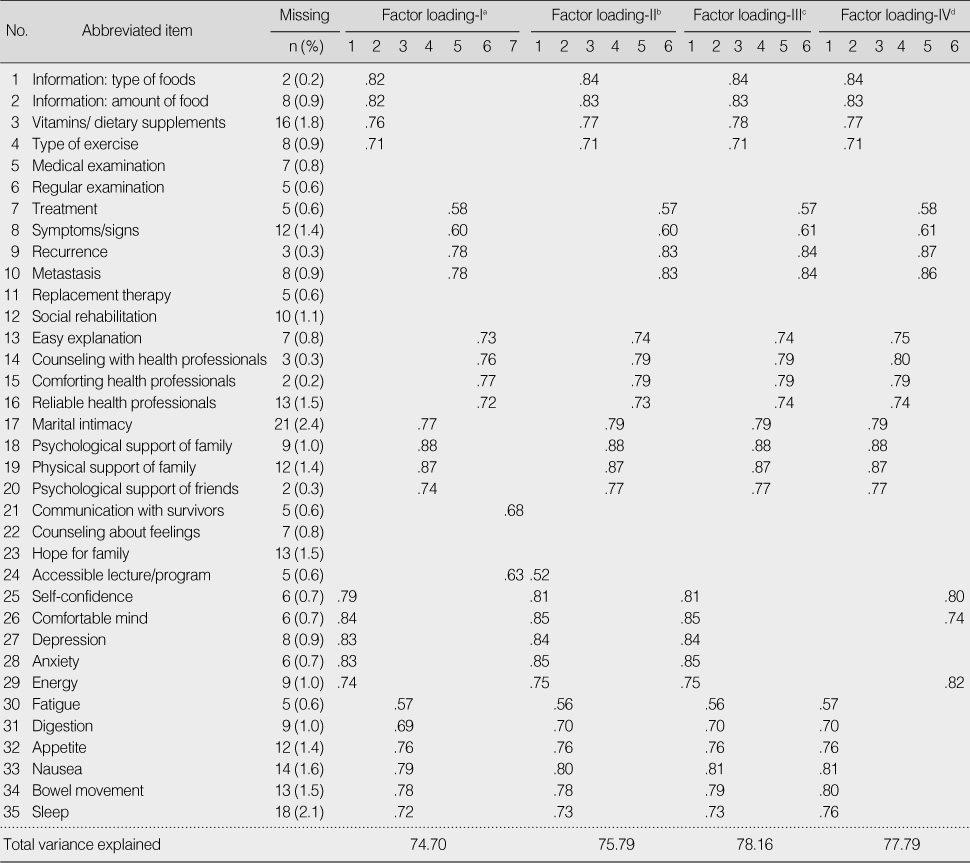
Criterion value of loading>.50.
a Kaiser-Meyer-Olkin (KMO)=.94, Bartlett's test of sphericity=23,296.07, p<.001; bKaiser-Meyer-Olkin (KMO)=.93, Bartlett's test of sphericity=19,846.11, p<.001; cKaiser-Meyer-Olkin (KMO)=.93, Bartlett's test of sphericity=18,941.00, p<.001; dKaiser-Meyer-Olkin (KMO)=.92, Bartlett's test of sphericity=6,233.51, p<.001.
Figure & Data
REFERENCES
Citations

- The Nursing Needs Assessment Scale for Women with Infertility: Turkish Validity and Reliability Study
Tugba Bozdemir, Hatice Yıldız, Jummi Park
Clinical and Experimental Health Sciences.2024; 14(4): 1048. CrossRef - Care Needs of Advanced Cancer Patients in a Long-term Care Hospital: Patient-Nurse Comparison
Hee-Jung Kang, Kyung-Ah Kang
Asian Oncology Nursing.2023; 23(4): 196. CrossRef - Nursing needs assessment scale for women with infertility: development and validation
Jummi Park, Nayeon Shin, Kyungmi Lee
Korean Journal of Women Health Nursing.2020; 26(2): 141. CrossRef - Unmet needs of non‐Hodgkin lymphoma survivors in Korea: prevalence, correlates, and associations with health‐related quality of life
Soo Hyun Kim, Suyeon Lee, So Hee Kim, Oh Nam Ok, Im‐Ryung Kim, Eunju Choi, Yoon‐Koo Kang, Seok Jin Kim, Moon Hee Lee
Psycho-Oncology.2017; 26(3): 330. CrossRef - Reliability and Validity of the Korean Version of the European Organization for Research and Treatment of Cancer Quality of Life Questionnaire to Assess Chemotherapy-induced Peripheral Neuropathy
Hye Young Kim, Jeong Hee Kang, Hyun Jo Youn, Hyang Sook So, Chi Eun Song, Seo Young Chae, Sung Hoo Jung, Sung Reul Kim, Ji Young Kim
Journal of Korean Academy of Nursing.2014; 44(6): 735. CrossRef - Effects of Horticultural Therapy Program on State-Anxiety, Fatigue and Quality of Life among Women Cancer Survivors
Kyong Ok Oh, Moon Hee Gang, Kwon Sook Jung
Asian Oncology Nursing.2012; 12(2): 125. CrossRef - Development and Validation of the Hospice Palliative Care Performance Scale
So-Hi Kwon
Journal of Korean Academy of Nursing.2011; 41(3): 374. CrossRef - Development and Validation of a Scale Assessing Spiritual Needs for Korean Patients with Cancer
Jinsun Yong, Juhu Kim, Sung-Suk (SR. Salecia) Han, Christina M. Puchalski
Journal of Palliative Care.2008; 24(4): 240. CrossRef

Figure 1
Characteristics of Participants in Interviews, (N=30)
Characteristics of Participants for Psychometric Evaluation, (N=873)
Frequencies and Percentages of Missing Values and Factor Loadings
Criterion value of loading>.50.
a Kaiser-Meyer-Olkin (KMO)=.94, Bartlett's test of sphericity=23,296.07, p<.001; bKaiser-Meyer-Olkin (KMO)=.93, Bartlett's test of sphericity=19,846.11, p<.001; cKaiser-Meyer-Olkin (KMO)=.93, Bartlett's test of sphericity=18,941.00, p<.001; dKaiser-Meyer-Olkin (KMO)=.92, Bartlett's test of sphericity=6,233.51, p<.001.
Inter-subscale Correlations and Reliability Coefficients of Each Subscale
*p<.001.
( )=Cronabch's alpha of each subscale; PS=physical symptoms; DE=diet and exercise; S=support; RHP=relationship with health professionals; TP=treatment and prognosis; KMC=keeping mind under control.
Multitrait/Multi-Item Matrix (Correlation Matrix Corrected for Overlap) for Item Convergent and Item Discriminant
PS=physical symptoms; DE=diet and exercise; S=support; RHP=relationship with health professionals; TP=treatment and prognosis; KMC=keeping mind under control. Standard error of a correlation coefficient=1 divided by the square root of the sample.
Criterion value of loading>.50. a Kaiser-Meyer-Olkin (KMO)=.94, Bartlett's test of sphericity=23,296.07,
* ( )=Cronabch's alpha of each subscale; PS=physical symptoms; DE=diet and exercise; S=support; RHP=relationship with health professionals; TP=treatment and prognosis; KMC=keeping mind under control.
PS=physical symptoms; DE=diet and exercise; S=support; RHP=relationship with health professionals; TP=treatment and prognosis; KMC=keeping mind under control. Standard error of a correlation coefficient=1 divided by the square root of the sample.
 KSNS
KSNS
 E-SUBMISSION
E-SUBMISSION
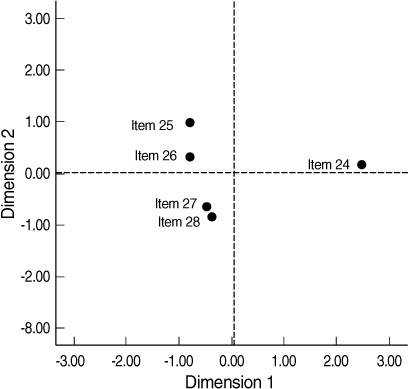
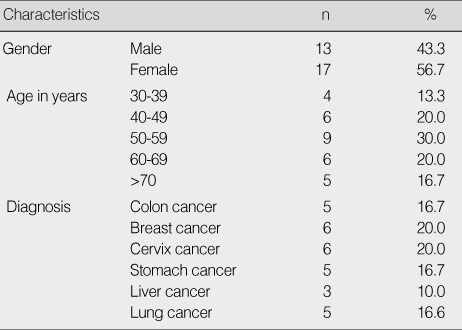
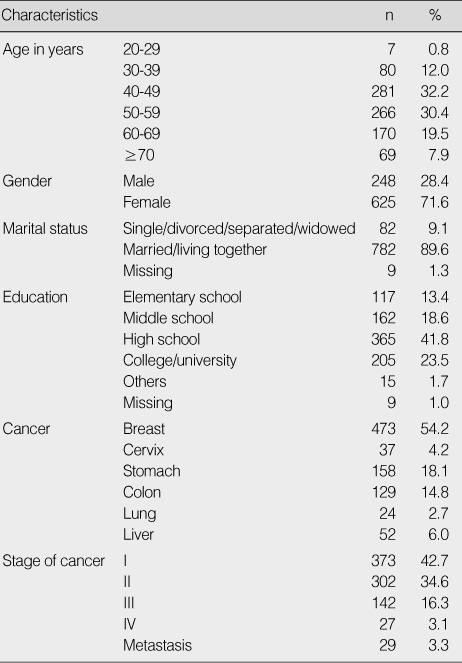
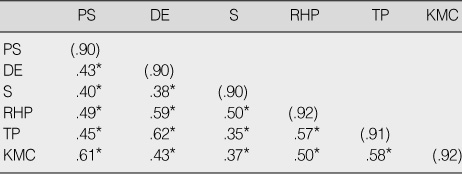
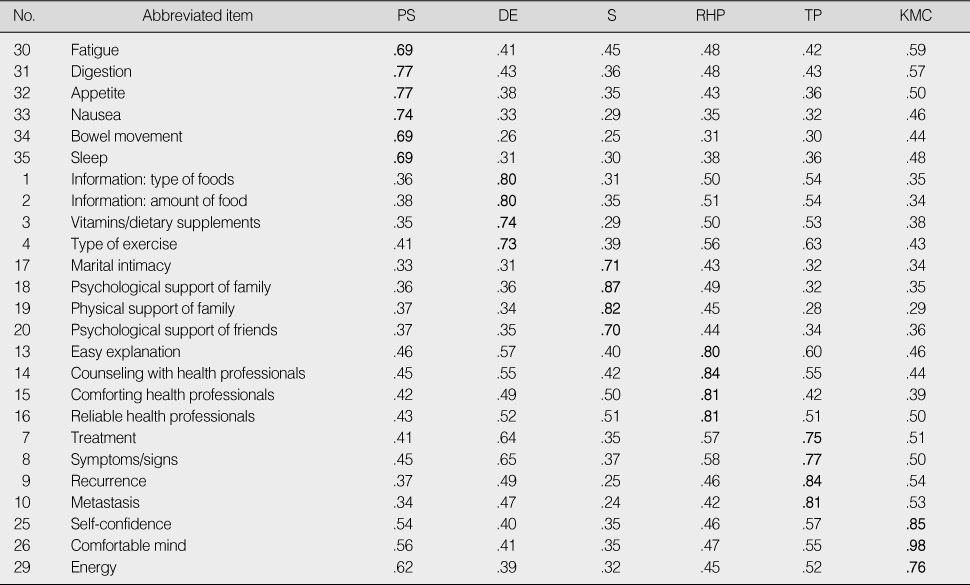
 Cite
Cite

